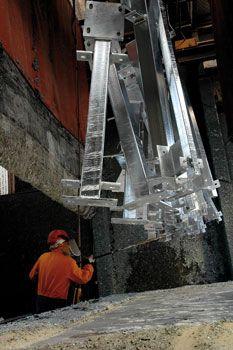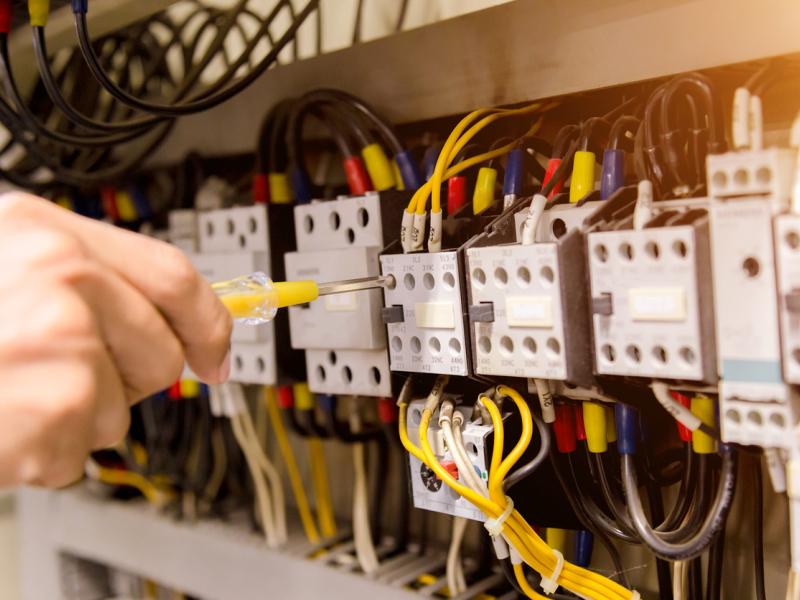|
The steel galvanizing process has been around for 180 years – and one of the earliest galvanized steel structures in Australasia, despite 130 years of exposure to harsh environmental conditions, is still untouched by the effects of corrosion. In 1996 the Galvanizing Association of Australia (GAA) examined 20 of the remaining steel poles used on the first Morse Code Line in Australia. Six thousand galvanized Oppenheimer telegraph poles were erected over a 4,300km distance from Darwin to Adelaide and from Thursday Island to Charters Towers in Far North Queensland in 1885. GAA tests showed that the 20 poles retained extremely heavy galvanized coating thicknesses, a silent testament to the longevity of steel products treated with hot dip galvanizing. This, says Galvanizing Association of New Zealand (GANZ) marketing committee member Brendan Bass, proves a point: “In an environment of constant global industrial progress, engineers and builders use hot dip galvanizing with the same confidence as a century ago. “It has produced optimum results from the time of its invention to this day with only peripheral changes in the technology. Then, it was called a product that makes good sense. Now, it’s called a product that has low embodied and operational energy,” he says. GANZ represents 14 New Zealand comp-anies involved in galvanizing. Formed 23 years ago, its mission is “to enhance the product and productivity of the industry”. It provides after-fabrication galvanizers, architects, engineers, fabricators, and specifiers with technical and practical support for innovative solutions on all aspects of hot dip galvanizing application, bolting, design, process, welding, and painting of galvanized steel. It also has a close relationship with the GAA. Bass says using galvanized steel is a Kiwi institution. “Over the past century-and-a-half it has made its reputation with farm gates, iron roofs, trailers, and structures of all kinds. Remember much of our construction takes place at or near the coastline. In addition our soils have varying acidity depending on location. “Hot dip galvanizing is a sure method of reducing exposure to rust or component failure. With the focus on sustainability in the construction, engineering and manufacturing sector, we at GANZ believe using the galvanizing option can positively impact on all aspects of design, construction, achieving long-term reductions in maintenance, and extending whole of life material performance,” he says. How galvanising works Bass explains the history, reasons for and process of hot dip galvanizing. A Parisian civil engineer, Stanislaus Sorel, filed a patent in May 1837 for the preservation of iron from rust. He specified either coating it completely in a bath of molten zinc (the parent of the hot dip galvanizing process) or covering it with zinc paint. This is because steel reacts electrochemically with oxygen, moisture, and pollutants dissolved in the moisture in its environment. Contact with the above cause small electrolytic cells, comprising anodes and cathodes, to form on the steel surface. This causes positively charged iron ions to form, which attract and react with negatively charged hydroxyl ions in the oxygen, moisture, and dissolved pollutants. The result is iron oxide, also known as rust. It is an inevitable process that can only be stopped in two ways. The first is to completely coat the steel to exclude air, moisture and pollutants. The second is to attach a cathodic metal to the steel that is more electrochemically active than the steel. When zinc attaches to the steel it assumes the role of anode for the steel, preventing the formation of anodic and cathodic areas, the precursors to rust, forming on the steel’s surface. Bass says only galvanizing can do both jobs simultaneously. He says the secret of galvanizing’s effectiveness is the integrity of the unique structural bond molten zinc forms with the steel’s surface. “Properly prepared and coated, a galvanized piece can last up to seven times longer than uncoated steel and significantly outlast most painted or coated systems,” he says. Following a few basic rules when designing a structure to be galvanized will ensure a durable quality coating, the desired surface finish, and no warping or structural damage to the material. In addition, prior to galvanizing, steel must be thoroughly prepared and cleaned, and adequate drain and venting holes provided for the escape of hot gases and molten zinc. The process is relatively simple – a crane operator dips the steel in a caustic solution bath to remove dirt, grease, and oils on the surface. The steel is then dipped in a hydrochloric acid solution bath to remove surface rust and scale, and rinsed. Next comes a dip in a flux bath to remove and prevent the oxide film that forms on the highly reactive steel surfaces after acid cleaning. This is done to ensure a complete coverage and bond. The operator then carefully lowers the item into the molten zinc bath, ensuring all areas are fully submerged. When the molten zinc comes into contact with the steel, a reaction takes place and the zinc forms an alloy with the steel that is metallurgically bonded to the steel. Four layers of alloy now cover the steel. The Gamma layer is a thin molecular layer containing 21 to 28 percent iron. The Delta layer above it is a zinc-iron alloy containing seven to 12 percent iron. The Zeta layer alloy contains 5.8 to 6.25 percent iron, and the top Eta layer is an almost pure zinc coating. Says Bass: “These lower alloys are often stronger than either the base metal or the zinc. In addition, the zinc will corrode sacrificially in preference to the steel – and zinc corrodes at a much slower rate than steel. It protects the steel from rust and damage even when small areas of the steel become exposed.” The technician now dips the newly galvanized steel into a dichromate bath to avoid white rust and prolong the silver finish of the zinc. They grind off drips and remove zinc spikes and extra zinc to leave a clean surface. If desired, galvanized items can be painted for extra protection and visual effect. Why it works Bass says galvanizing offers the materials specifier several benefits. Galvanizing is carried out to AS/NZS4680, which specifies standard, minimum coating thicknesses to be applied. Coating life and performance are therefore reliable and predictable. The reaction between the steel and molten zinc in the galvanizing bath does not occur unless the steel surface is chemically clean. Therefore, he says, galvanizing is self-evaluating. “If a galvanized coating looks sound and continuous, it is.” Although perceived as expensive, it is cost effective. “Galvanizing is lower in first cost than many other commonly specified protective coatings for steel. |
For example, the labour component of finished paint coatings averages about 60 percent, compared with about 30 percent for galvanizing,” says Bass. “Even where the initial cost of galvanizing is higher, galvanizing is almost invariably cheapest in the long term because it lasts longer and needs less maintenance, especially when structures are located in remote areas, and when plant shutdown or disruption to production is involved. “The life expectancy of galvanized coatings on typical structural members is far in excess of 50 years in most rural environments, and up to 25 years plus in severe urban and coastal exposure,” he says. It is also durable and practical. Bass says the coating’s metallurgical structure lends it “outstanding resistance to mechanical damage in transport, erection and service. Every part of a galvanized article is protected, even edges, recesses, sharp corners, and inaccessible areas.” Turnaround time is reasonably fast, the process is not dependent on weather conditions and galvanized steel sections arrive on site ready for use. In addition, he says, using galvanized steel has the highly desirable outcome of reducing both the embodied and operational requirements of structures. In particular, Bass says hot dip galvanizing is one of the few industries that have a recyclable solution that reduces the energy demands of structures. Zinc is a non-ferrous metal that can be recycled indefinitely without any loss of its physical or chemical properties. “This is a major advantage for the hot dip galvanizing process, ensuring its environmental sustainability and its cost effectiveness,” he says. Where it works Numerous owners of structures using galvanized steel in Australia and New Zealand will agree that galvanizing results in a durable product. In the late 1920s Victoria’s State Electricity Commission completed two 132kV power lines from the Latrobe Valley to Melbourne, terminating at Richmond in the east of the city and Yarraville to the west. Eighty years later, it is still operational. Shell Australia’s petrochemical plant in the harsh marine environment of Corio near Geelong, Victoria, is now 39 years old. The galvanized steel walkways at Huntly Power Station and the Port of Tauranga are respectively 30 and 11 years old. Auckland’s Sky Tower’s recently opened walkway and the Wainoni Park Archway in North Shore City also showcase how practicalities can be combined with aesthetics. The Orams Marine Mega Boat Park in Auckland’s Westhaven Marina is a Kiwi landmark. In 2004 Orams expanded its boat park with an ingenious stacking system. The facility can now house 370 vessels, up to 40 feet long, and is securely supported on hot dip galvanized beams. The framing’s structural sections, also hot dip galvanized, are up to 11 metres long. Bass says the majority of New Zealanders live and work in coastal communities. They use steel to manufacture and build every day. “Steel, especially in coastal areas, needs protection. In chloride environments, improper coatings actually accelerate corrosion by allowing contaminants and moisture to reach the surface of the steel. This can result in a glasshouse effect. “Hot dip galvanizing is also the most viable means of protecting reinforcing rods or re-bar, particularly in a coastal climate or where the impermeability of concrete for the design life of the structure cannot be guaranteed. Research and practical experience since the 1950s have shown the corrosion resistance of galvanized steel reinforcement to be greatly superior to that of uncoated steel. “There’s a reason why galvanizing is one of the oldest coating methods used in industry,” says Bass. “It’s simply because it works so well. The current and future rising cost of steel means it’s more important than ever for project owners to protect their assets.” For more information on hot dip galvanising visit www.galvanising.org.nz
|






